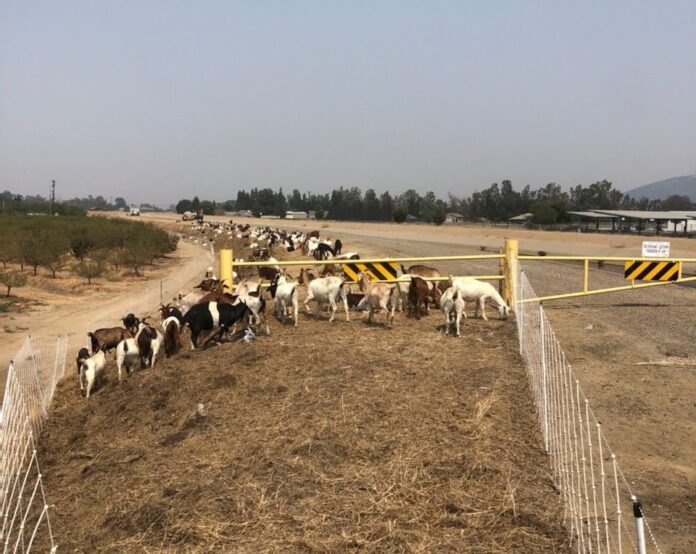 The Kaweah Delta Water Conservation District held its Tuesday, February 1, 2022 board meeting in person at its Farmersville headquarters and on the non-Zoom global go to meeting. Last month folks were happy, cruising along from the very wet December. I’ve said it many times, farmers are like ducks and frogs, they like it when it rains, provided it’s not during blossom set and harvest. Well, it hasn’t rained since December and there is none in the immediate forecast. That doesn’t mean everyone will automatically be in a bad mood, just that there will be less of a celebration.
The Kaweah Delta Water Conservation District held its Tuesday, February 1, 2022 board meeting in person at its Farmersville headquarters and on the non-Zoom global go to meeting. Last month folks were happy, cruising along from the very wet December. I’ve said it many times, farmers are like ducks and frogs, they like it when it rains, provided it’s not during blossom set and harvest. Well, it hasn’t rained since December and there is none in the immediate forecast. That doesn’t mean everyone will automatically be in a bad mood, just that there will be less of a celebration.
The Meeting
The meeting was scheduled to begin at 9:00am and Chairman Don Mills didn’t disappoint. The only public comment was from General Manager Mark Larsen who introduced a new addition to the staff. A young lady from Fresno State I believe, will be working mostly on GSA matters.
The Sino Cooties have prompted a new policy, something structured to respond to Covid. The proposal is a temporary measure where employees can get five days of paid leave if they test positive. Mills said he’s read through this, attorney Aubrey Mauritson has reviewed it. Mills said he doesn’t want to see a policy for every disease, no measles and such. This policy will have a sunset clause in 120 days. The board agreed.
Water Supply
Water Master Vic Hernandez said he’s spoken with the Army Corps of Engineers about space at the reservoir on the Kaweah River. He also spoke with the folks in the Tulare Lakebed and since it’s so dry and there is nothing in the forecast he doesn’t see a threat from an early runoff forcing a flood release and recommends keeping as much in storage as possible. He reviewed several past years with similar hydrology when formulating the recommendation. If there is average rainfall from now to the end of the season there still wouldn’t be a rush to make room for flood water. Hernandez said the water content in the snow now at the upper elevations is pretty good. They are going to have to determine if three ASO flights are warranted. It sounded like maybe two were enough this year.
recommendation. If there is average rainfall from now to the end of the season there still wouldn’t be a rush to make room for flood water. Hernandez said the water content in the snow now at the upper elevations is pretty good. They are going to have to determine if three ASO flights are warranted. It sounded like maybe two were enough this year.
Another item up for grabs is water trading. Engineer Dennis Keller said there is no reason to run before the third week of February. There are some swaps out there and there are districts with small amounts, too small to run that can be pieced together. He reminded everyone there is still a 20 percent Class I allocation from Friant.
CVP
Keller said the US Bureau of Reclamation has done a good job of moving as much water as possible into San Luis Reservoir. He doesn’t see a scenario where the Exchange Contractors will get a full allocation. Shasta isn’t doing well and temperatures are rising. Keller said there is a lady, didn’t catch her name, working for the Bureau at the Delta and she has been very on top of running the pumps anytime they can run.
Every year Central Valley Project contractors on the Friant Kern Canal have to approve a 215 Contract. This is water that has to be evacuated from Millerton Lake to make room for flood water. It is usually very cheap and the board agreed to the contract.
Friant Matters
Larsen said the groundbreaking on the Friant Kern Canal is a good start. He showed the board some of the costs associated with the repairs and who will pay how much. There is still a shortfall in total funding. Part of the money comes from the state, Eastern Tule GSA, federal funds and Friant contributions. Director Chris Tantau represents Kaweah Delta on the Friant board and said the growers in Eastern Tule are trying to avoid pumping as much as possible and that will impact how much goes to FKC repair. Eastern Tule is also looking at a 218 Election, that’s the vote that raises the assessment or not. Tantau said the preliminary work Friant Water Authority staff has done along with others, is very encouraging.
federal funds and Friant contributions. Director Chris Tantau represents Kaweah Delta on the Friant board and said the growers in Eastern Tule are trying to avoid pumping as much as possible and that will impact how much goes to FKC repair. Eastern Tule is also looking at a 218 Election, that’s the vote that raises the assessment or not. Tantau said the preliminary work Friant Water Authority staff has done along with others, is very encouraging.
There was a problem at the O’Neil Forebay where the California Aqueduct and the Delta Mendota Canal meet to fill the San Luis Reservoir. For some reason they couldn’t get the water to SLR and as a result the duck clubs and wildlife refuges got a lot of unexpected water that would have gone to storage.
Hannah Ranch
Keller said the Hannah Ranch structure is close to finishing. He listed many parts and pieces. There was a power loss on a check on the FKC and there has been some trading going on. Kaweah Delta will provide power for Friant and in return Friant will be doing some electrical work for Kaweah Delta in trade. He also said starving artists have been painting their stylized initials on the paneling at the turnout. Their parents must be proud.
There is a traffic control plan that will shut down Avenue 245 for a week while work is done in the right of way. That will cause some detours in the Woodlake area. That’s pending Caltrans approval that could slow things somewhat depending how quickly Caltrans responds.
Greater Kaweah GSA
GKGSA Executive Director Eric Osterling said the board met and released some draft regulations for a pumping cap. There will be a series of workshops to garner public comment for the next 90-days. He said depending on what happens with coordination between the Kings Subbasin and the Kaweah there could be impacts the monitoring dashboard.
Osterling said DWR sent GKGSA a love letter saying the Groundwater Sustainability Plan was incomplete. The letter wasn’t very detailed and the GSA is seeking a meeting with DWR to discuss what is going on. There’s only 180 days to turn this around but within this time frame there is a 90-day comment period so time is tight as Booker T used to say.
Osterling said the GSA has submitted some current work for the project grant money. There is a good chunk of change available for land fallowing activities. The gooberment calls it land repurposing. There will be a management team meeting tomorrow and Mills said the goal is to submit as much grant funding requests as possible to show the drastic need. He wanted to know how this will impact scoring for grants. If I understood the Mid Kaweah and East Kaweah GSAs have already determined their projects. He did say the Delta View Water Association’s projects look to score well. The DVWA is a group of landowners in the white area within GKGSA. This round of grant funding isn’t very competitive and if a GSA elsewhere doesn’t put in for as much the funding could go higher.
Osterling was asked if he knew when the pump cap might be implemented. Osterling said Hernandez’s report wasn’t good and it could hit as early as April. But the plan is next October if possible. East Kaweah GSA has implemented its cap retroactively. Mills said he is completely opposed to retroactive punitive measures. He said there’s a massive legal threat down that road.
Land IQ is being used subbasin wide to determine ET and has been well received. The same format and measuring criteria is used throughout the entire Kaweah Subbasin. Osterling said Land IQ does a lot of ground truthing and most of the discrepancies are being ironed out. There will always be some questions. Dairies and nurseries with closed systems are a challenge due to the recycling. Fallowed land also. Osterling said irrigated land and wells are all going to be registered this April. Keller pointed out it might be more of an adjustment by the GSA than Land IQ.
Osterling said there is a resolution for a project in the agenda packet but come to find out it wasn’t necessary. I’ve heard DWR is using the newest, lowest paid staff possible to do the GSP reviews. Osterling said DWR has been very helpful and is willing to work with the GSAs on points of subjective opinion. He did say there seems to be some NGO influences that added comment on things not in the law.
Other Stuff
Larsen updated the board on the Kaweah Oaks Preserve Project. He said the area has been proven to be a good site for recharge. He said Krazan Engineering is doing some borings to verify the clay and sand layers. He also said the Tulare Lakebed interests are very much wanting to be a part of this. He said grant scoring should be good.
Closed Session
The meeting went into closed session at 10:05am and the next meeting will be March 1st. There were two potential lawsuits to discuss in closed session. And that was that.
There were two potential lawsuits to discuss in closed session. And that was that.
DISCLAIMER OF RESPONSIBILITY; Waterwrights.net strives to provide readers and clients with the most complete, up-to-date, and accurate information available. Nevertheless, Waterwrights.net does not serve as a guarantor of the accuracy or completeness of the information provided, and specifically disclaims any and all responsibility for information that is not accurate, up-to-date, or complete. Waterwrights.net’s clients therefore rely on the accuracy, completeness and timeliness of information from Waterwrights.net entirely at their own risk. The opinions expressed in this report are those of the author and do not represent any advertisers or third parties.
ALL RIGHTS RESERVED. Copyright 2022 by www.WaterWrights.net/DAW
Kaweah Delta Water Conservation District
2975 N. Farmersville Blvd.
Farmersville, California 93223
559/747-5601 KDWCD is part or the Greater Kaweah GSA DWR #5-022.11
Board of Directors
Don Mills – President, Chris Tantau – Vice-President, Ron Clark, Jimi Valov, Jeff Ritchie, Mike Chrisman & Brian Watte
Management
Mark Larsen, General Manager – mlarsen@kdwcd.com
Terry Stafford, Facilities Manager – tstafford@kdwcd.com
Debbie Vierra, Administrative/HR Coordinator – dvierra@kdwcd.com
Larry Dotson, Senior Engineer – ldotson@kdwcd.com
Shane Smith, Projects/Administrative Manager – ssmith@kdwcd.com
Office and Field Staff
Water Master – Victor Hernandez
Office Assistant – Kathleen Halvorsen
Primary ConsultantsDennis Keller – Civil Engineer (Keller/Wegley Consulting Engineers)
Aubrey Mauritson – Attorney (Ruddell, Cochran, Stanton, Smith & Bixler, LLP)
From the Kaweah Delta website:
The Kaweah Delta Water Conservation District (KDWCD) was formed in 1927, under the provisions of California state law known as the Water Conservation Act of 1927, for the purpose of conserving and storing waters of the Kaweah River and for conserving and protecting the underground waters of the Kaweah Delta. Later the Water Conservation Act, as well as the purpose of the District, was expanded to include power generation and distribution.
The District is located in the south-central portion of the San Joaquin Valley and lies in portions of both Tulare and Kings Counties. The total area of the District is about 340,000 acres with approximately 255,000 acres located in the western portion of Tulare County and the balance, or 85,000 acres, in the northeastern portion of the Kings County.
The Districts lands are primarily agricultural in nature, although the cities of Visalia and Tulare constitute significant areas of urbanization. Farmersville is the other incorporated area. The population of the District is currently estimated to be in excess of 175,000 people with the principle crops being cotton, misc. field crops, deciduous fruit and nut trees as well as alfalfa.
Numerous public and private entities within the District’s boundaries divert water from the Kaweah River and its distributaries. Nearly all of the lands served with Kaweah River water also are served irrigation water from groundwater, primarily due to the erratic and relatively undependable nature of flow on the Kaweah River. All municipal and industrial water uses within the District are supplied from groundwater.
KDWCD and Tulare Irrigation District (TID), which lies entirely within the boundaries of the Kaweah Delta Water Conservation District, has a long-term contract with the federal Central Valley Project (CVP) for water from the Friant Division of the CVP. TID has historically received substantial quantities of CVP water surplus to the demands of the District which augment the Kaweah River supply.
The District and the Kaweah River groundwater basin have experienced long-term groundwater overdraft estimated in 2007 to be as much as 40,000 acre-feet per year. The District has performed multiple studies of groundwater data to determine the extent and volume of groundwater overdraft within its boundaries. There are currently over 40 recharge basins within the District covering approximately 5,000 acres. While KDWCD owns and operates many of these groundwater recharge basins, it does not provide water banking services for others.
































